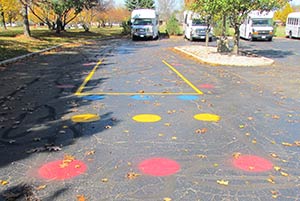
Fleet Vehicle Safety: On the Move for 2014Loss and exposure-based risk management continues to be the best way for PDRMA members to reduce their costs and to keep staff and patrons safe. In 2014, PDRMA is focusing on fleet vehicle safety.
“Over the past five years (2008–2013), member auto liability claims totaled more than $1.5 million, and physical damage to agency vehicles/property exceeded $1.5 million,” explains Dane Mall, PDRMA Risk Management Services Manager. “And that doesn’t include agency vehicle damage that’s under PDRMA’s $1,000 deductible and paid directly by an agency.
“If your agency has a great fleet-safety program, and your loss reports show you’re successfully handling this risk,” says Mall, “it may not be a training priority. But if your agency suffers consistent losses in this area, now is a good time to begin managing this risk using PDRMA resources.”
  Mirror, Mirror, on the…Truck? Mirror, Mirror, on the…Truck?
One of the most important safety features in a vehicle has only a few moving parts, doesn’t need gas or electricity, and can be cleaned with a quick wipe of a cloth: the mirrors.
That’s why the Northern Illinois Special Recreation Association (NISRA) took a unique approach to maintain proper mirror adjustment in their nine vehicles…and earned a 2012 PDRMA Risk Management Grant and Recognition Program award for their Mirror Station training course.
“NISRA’s nine activity buses and accessible mini-buses provide community access for our participants,” explains Dana Seehafer, NISRA Senior Manager, Operations. “Our Mirror Station Program properly trains drivers to adjust mirrors correctly and use them properly when driving. It also lets the public see agency drivers demonstrating best driving-safety practices.”
The mirror station consists of three different-colored circles painted in a specific pattern on the ground to train drivers how to adjust each vehicle’s six mirrors. “When the drivers pull into the grid, they learn what they should see in each mirror,” explains Transportation Coordinator Jeri Burkett. “For example, the bottom small mirror on the larger side-view mirror should show the vehicle wheels so the driver can avoid hitting curbs.”
“Before the mirror station, we had at least three tire repairs in one season; drivers couldn’t see the curb when making right-hand turns,” adds Seehafer. “They would hit or go over the curb, causing damage to the tire and rim. Now drivers can just pull into the grid areas, make a quick adjustment and head out knowing their blind spots are more visible after using the mirror station.”
Since the program started, some 45 drivers have been trained, and the mirror station is included in all new driver training. NISRA also added a convex mirror to the station, positioned so drivers can check all lights in the rear of the vehicle to be sure they are working. The driver training combines video and hands-on instruction and takes approximately two hours.
“People don’t realize the mirrors need to be re-adjusted every time a driver gets in the vehicle to account for the height of the driver,” notes Burkett. “Drivers take mirror adjustment for granted because they get in and out of their personal car daily. But our vehicles can have three different drivers in one day.”
Distracted Driving Is the Greatest Danger
However, even the most perfectly placed mirrors are worthless if the driver is distracted. Hand-held cell phone use while driving is illegal in Illinois. Research shows that even when using a hands-free device, drivers’ skills were rarely any better than if they had been holding a phone, according to the National Safety Council.
“The leading causes of auto accidents for PDRMA members over the past five years are failure to yield right of way, being struck by another vehicle and backing up,” Mall notes. “What we’ll never know is how much of a role distracted driving played in causing those incidents.”
After addressing mirror adjustment in training staff drivers, NISRA decided to take it one step further. “We also do training on distracted driving,” adds Burkett. “We ride along with our drivers (on a closed training course), and have our staff get in the 15-passenger bus and act like unruly passengers — singing and yelling and even throwing things. We want to make sure our drivers never take their eyes off the road or their mirrors, even when driving backwards through obstacle courses we make by placing cones on the ground.” If passengers get out of control while driving, Glenview advises their drivers to stop the vehicle in a safe location to address any problems on the bus.
Even without the ability to mimic the elements of distracted driving, you still can show staff the importance of remaining attentive when driving. PDRMA’s Cell Phone Safety — LRN #535 reviews when and how to use a cell phone when driving, and two DVDs — Distracted Driving: Game Over LRN #4024 and Driving Distractions: Are You Playing with a Full Deck? — are available upon request. The National Safety Council also has a number of distracted driving resources that are free to download. (See Don’t Get Distracted — Register for Training Now.)
“It’s a good idea to remind staff drivers of the dangers of distracted driving regardless of your agency’s loss history,” says Mall. “It only takes one accident to impact someone’s life dramatically. Keeping distracted-driving prevention at the forefront of your drivers’ minds goes a long way to managing your risk and saving lives.” |

